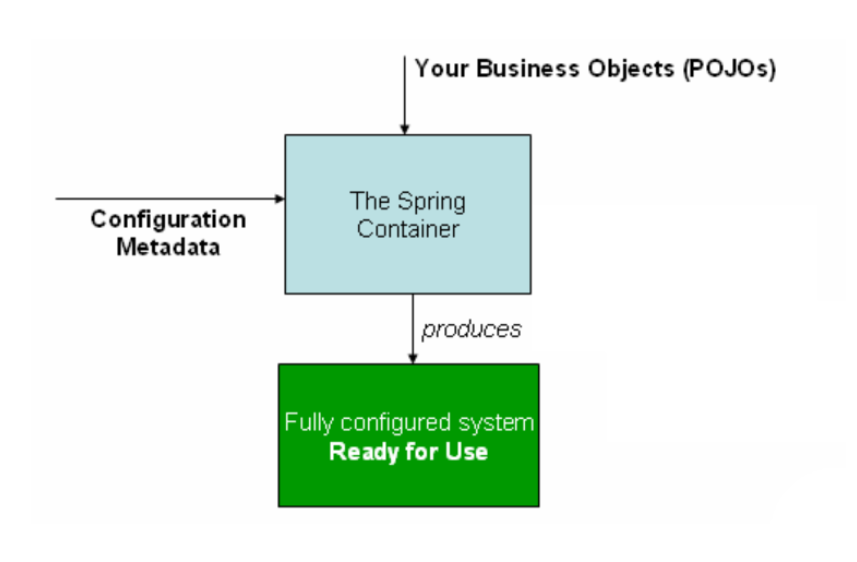DI (Dependency Injection)
1、依赖注入,组件之间的依赖关系由容器在运行期间决定。Ioc容器注入应用程序某个对象,它所需要的外部资源(包括对象,资源,常量数据)。
birthdate需要用到date类型的一个对象,引用了d的对象就是一种DI(依赖注入),s.setBirthdate( d )依赖一个date类型的对象,注入就是将date类型的对象set进去。
<bean id="d" class="java.util.Date" />
<bean id="s" class="io.spring.ioc.base.Student" >
<property name="id" value="1001" />
<property name="name" value="张三丰" />
<property name="gender" value="男" />
<property name="birthdate" ref="d" />
</bean>
相当于s.setBirthdate( d ),也可以指定内部的bean
<bean id="s" class="io.spring.ioc.base.Student">
<property name="id" value="1001" />
<property name="name" value="张三丰" />
<property name="gender" value="男" />
<property name="birthdate" >
<bean class="java.util.Date" />
</property>
</bean>
相当于s.setBirthdate( new Date )。
Spring Ioc容器
1、具有依赖注入功能的容器。负责实例化,定位,配置应用程序中的对象及建立这些对象间的依赖。在Spring中BeanFactory是Ioc容器的实际代表者。BeanFactory接口提供了IoC容器的基本功能。Spring Ioc容器通过读取配置文件中的配置元数据,通过元数据对应用中各个对象进行实例化及装配。

Spring IoC容器注入依赖资源的方式
1、Spring IoC容器注入依赖资源的方式有两种setter注入和构造方法注入。
2、setter注入, ( setter-base ),提供setter方法进行注入,依赖于无参构造和setter方法
- Spring Framework 3.0 之前 ,使用property标记来来指定属性的注入值
<bean id="customer" class="ecut.ioc.di.Customer" > c.setId(1002) <property name="id" value="1002" /> <property name="name" value="张翠山" /> <property name="gender" value="男" /> <property name="birthdate" ref="date" /> </bean>通过bean标记来声明这个bean,使用bean标记的id或name属性来指定bean的名称 , bean的class属相来指定bean的类型(具体的不是抽象的,不然需要修改abstract属性为true),name属性指定setter方法对应的名称,比如setBirthdate就写birthdate,ref属性用来指定需要引用的那个已经存在的bean的名称,普通类型用value,需要引用的类型使用ref。
- Spring Framework 3.0 开始支持 p 命名空间为属性注入值 ,也依赖于无参构造和setter方法
<!-- setter方法注入, 使用P命名空间(property namespace,需要提供p命名空间)--> <bean id="customer" class="ecut.ioc.di.Customer" p:id="1002" p:name="张翠山" p:gender="男" p:birthdate-ref="date" />普通类型p:name="value",需要引用的类型使用p:name-ref="引用bean的id"
- 测试案例
Customer类
package ecut.ioc.di; import java.util.Date; public class Customer { private Integer id; private String name; private char gender; private Date birthdate; public Customer() { super(); System.out.println( "调用 Customer 无参构造创建对象" ); } public Customer(Integer id, String name, char gender) { super(); this.id = id; this.name = name; this.gender = gender; System.out.println( "调用 Customer( Integer , String , char ) 创建对象" ); } public Customer(Integer id, String name, char gender, Date birthdate) { super(); this.id = id; this.name = name; this.gender = gender; this.birthdate = birthdate; System.out.println( "调用 Customer( Integer , String , char , Date ) 创建对象" ); } public Integer getId() { return id; } public void setId(Integer id) { this.id = id; System.out.println( "为id属性赋值: " + id ); } public String getName() { return name; } public void setName(String name) { this.name = name; System.out.println( "为name属性赋值: " + name ); } public char getGender() { return gender; } public void setGender(char gender) { this.gender = gender; System.out.println( "为gender属性赋值: " + gender ); } public Date getBirthdate() { return birthdate; } public void setBirthdate(Date birthdate) { this.birthdate = birthdate; System.out.println( "为birthdate属性赋值: " + birthdate ); } }setter-injection.xml
<?xml version="1.0" encoding="UTF-8"?> <beans xmlns="http://www.springframework.org/schema/beans" xmlns:xsi="http://www.w3.org/2001/XMLSchema-instance" xmlns:p="http://www.springframework.org/schema/p" xsi:schemaLocation="http://www.springframework.org/schema/beans http://www.springframework.org/schema/beans/spring-beans-4.3.xsd"> <bean id="date" class="java.util.Date" /> <!-- setter方法注入, 使用P命名空间(property namespace,需要提供p命名空间)--> <bean id="customer" class="ecut.ioc.di.Customer" p:id="1002" p:name="张翠山" p:gender="男" p:birthdate-ref="date" /> <!-- 通过bean标记来声明这个bean 使用bean标记的id或name属性来指定bean的名称 , bean的class属相来指定bean的类型(具体的不是抽象的,不然需要修改abstract属性为true), name属性指定setter方法对应的名称,比如setBirthdate就写birthdate, ref属性用来指定需要引用的那个已经存在的bean的名称--> <!--Customer c = new Customer(); --> <!--<bean id="customer" class="ecut.ioc.di.Customer" > c.setId(1002) <property name="id" value="1002" /> <property name="name" value="张翠山" /> <property name="gender" value="男" /> <property name="birthdate" ref="date" /> </bean> --> </beans>测试类
package ecut.ioc.di; import org.springframework.context.support.AbstractApplicationContext; import org.springframework.context.support.ClassPathXmlApplicationContext; public class TestSetterInjection { public static void main(String[] args) { //指定configuration metadata配置元数据 String configLocations = "classpath:ecut/**/di/setter-injection.xml" ; //创建spring IOC容器 AbstractApplicationContext container = new ClassPathXmlApplicationContext( configLocations ); //ready for use (此时可以从指定的IOC容器中获取指定名称的bean实例了) Customer c = container.getBean( "customer" , Customer.class ); //从容器中获取的bean实例中获取属性值 System.out.println( c.getId() ); System.out.println( c.getName() ); System.out.println( c.getGender() ); System.out.println( c.getBirthdate() ); //关闭spring的IOC容器 container.close(); } }
3、构造方法注入 : ( constructor-base )通过构造方法往里面传入值
- 测试案例
constructor-injection.xml
<?xml version="1.0" encoding="UTF-8"?> <beans xmlns="http://www.springframework.org/schema/beans" xmlns:xsi="http://www.w3.org/2001/XMLSchema-instance" xmlns:p="http://www.springframework.org/schema/p" xsi:schemaLocation="http://www.springframework.org/schema/beans http://www.springframework.org/schema/beans/spring-beans-4.3.xsd"> <bean id="date" class="java.util.Date" /> <!-- constructor 调用有参数的构造 --> <bean id="customer" class="ecut.ioc.di.Customer" > <!-- 在bean标记内部使用constructor-arg标记来指定构造方法的参数为 , 也可以根据type匹配相应的参数如果这个类型参数唯一, 也可以指定index来指定参数,若和参数顺序一致index可以省略, name是指参数名称,value是指定的参数值 --> <constructor-arg name="id" type="java.lang.Integer" value="1003" /> <constructor-arg name="name" type ="java.lang.String" value="殷素素" /> <constructor-arg name="gender" value="女" /> <!-- 如果参数类型不是简单类型就需要使用ref去引用其他的bean --> <constructor-arg name="birthdate" ref="date" /> </bean> <!-- <bean id="customer" class="ecut.ioc.di.Customer" > 在bean标记内部使用constructor-arg标记来指定构造方法的参数为 , 也可以根据type匹配相应的参数如果这个类型参数唯一, 也可以指定index来指定参数,若和参数顺序一致index可以省略, name是指参数名称,value是指定的参数值 <constructor-arg type="java.lang.Integer" value="1003" /> <constructor-arg type ="java.lang.String" value="殷素素" /> <constructor-arg value="女" /> <constructor-arg ref="date" /> </bean> --> <!-- constructor 调用有参数的构造 --> <!-- <bean id="customer" class="ecut.ioc.di.Customer" > 在bean标记内部使用constructor-arg标记来指定构造方法的参数为 , 也可以根据type匹配相应的参数如果这个类型参数唯一, 也可以指定index来指定参数,若和参数顺序一致index可以省略, name是指参数名称,value是指定的参数值 <constructor-arg name="id" value="1003" /> <constructor-arg name="name" value="殷素素" /> <constructor-arg name="gender" value="女" /> <constructor-arg name="birthdate" ref="date" /> </bean> --> <!-- <bean id="customer" class="ecut.ioc.di.Customer" > 在bean标记内部使用constructor-arg标记来指定构造方法的参数为 , 也可以根据type匹配相应的参数如果这个类型参数唯一, 也可以指定index来指定参数,若和参数顺序一致index可以省略, name是指参数名称,value是指定的参数值 <constructor-arg value="1003" /> <constructor-arg value="殷素素" /> <constructor-arg value="女" /> <constructor-arg ref="date" /> </bean> --> <!-- <bean id="customer" class="ecut.ioc.di.Customer" > 在bean标记内部使用constructor-arg标记来指定构造方法的参数为 , 也可以根据type匹配相应的参数如果这个类型参数唯一, 也可以指定index来指定参数,若和参数顺序一致index可以省略, name是指参数名称,value是指定的参数值 <constructor-arg index="0" value="1003" /> <constructor-arg index="2" value="女" /> <constructor-arg index="1" value="殷素素" /> <constructor-arg index="3" ref="date" /> </bean> --> </beans>在bean标记内部使用constructor-arg标记来指定构造方法的参数为 ,也可以根据type匹配相应的参数如果这个类型参数唯一,也可以指定index来指定参数,若和参数顺序一致index可以省略,name是指参数名称,value是指定的参数值。
测试类
package ecut.ioc.di; import org.springframework.context.support.AbstractApplicationContext; import org.springframework.context.support.ClassPathXmlApplicationContext; public class TestConstructorInjection { public static void main(String[] args) { //指定configuration metadata配置元数据 String configLocations = "classpath:ecut/**/di/constructor-injection.xml" ; //创建spring IOC容器 AbstractApplicationContext container = new ClassPathXmlApplicationContext( configLocations ); //ready for use (此时可以从指定的IOC容器中获取指定名称的bean实例了) Customer c = container.getBean( "customer" , Customer.class ); //从容器中获取的bean实例中获取属性值 System.out.println( c.getId() ); System.out.println( c.getName() ); System.out.println( c.getGender() ); System.out.println( c.getBirthdate() ); //关闭spring的IOC容器 container.close(); } }如果在Customer类中写了带参数的构造最好写 无参构造,只写有参构造,虚拟机不会再分配无参构造, 因为没有提供无参构造会抛出异常BeanCreationException,没有找到默认构造方法 No default constructor found;
Spring IoC容器注入集合
1、Spring不仅能注入简单类型数据,还能注入集合(Collection、Set、List)类型、数组(Array)类型、字典(Map)类型数据、Properties类型数据。
2、3.0之前的注入方式:在 <property> 标签 内部 使用 set 、list 、map 、props 标签实现注入: normal-injection.xml
<?xml version="1.0" encoding="UTF-8"?>
<beans xmlns="http://www.springframework.org/schema/beans"
xmlns:xsi="http://www.w3.org/2001/XMLSchema-instance"
xmlns:util="http://www.springframework.org/schema/util"
xsi:schemaLocation="http://www.springframework.org/schema/util http://www.springframework.org/schema/util/spring-util-4.3.xsd
http://www.springframework.org/schema/beans http://www.springframework.org/schema/beans/spring-beans-4.3.xsd">
<bean id="birthdate" class="java.util.Date" />
<bean id="findFriend" class="java.util.Date" />
<bean id="user" class="ecut.ioc.collection.User">
<property name="id" value="1001" />
<property name="name" value="张三丰" />
<!-- 注入 Set 集合 -->
<property name="hobby">
<set>
<value>吃饭</value>
<value>睡觉</value>
<value>泡妞/被泡</value>
</set>
</property>
<!-- 注入 List 集合 -->
<property name="luckDay">
<list>
<!-- 如果不是基本数据类型及其包装类型,通过ref 来引用-->
<ref bean="birthdate"/>
<ref bean="findFriend"/>
</list>
</property>
<!-- 注入 Map 集合 -->
<property name="score">
<map>
<entry key="前端" value="45" />
<entry key="后端" value="54" />
</map>
</property>
<!-- 注入 Properties 集合 -->
<property name="address">
<props>
<prop key="软件楼">东理北门内,太谷路旁,软件楼一楼厕所边的那个门</prop>
<prop key="宿舍">东理南区研一好望角</prop>
</props>
</property>
</bean>
</beans>
3、3.0全新的注入方式:使用 Spring 3.0 开始提供的 util 命名空间,结合 <property> 或 p 命名空间实现注入: util-injection.xml
<?xml version="1.0" encoding="UTF-8"?>
<beans xmlns="http://www.springframework.org/schema/beans"
xmlns:xsi="http://www.w3.org/2001/XMLSchema-instance"
xmlns:util="http://www.springframework.org/schema/util"
xsi:schemaLocation="http://www.springframework.org/schema/beans http://www.springframework.org/schema/beans/spring-beans-4.3.xsd
http://www.springframework.org/schema/util http://www.springframework.org/schema/util/spring-util-4.3.xsd">
<bean id="birthdate" class="java.util.Date" />
<bean id="findFriend" class="java.util.Date" />
<util:set id="hobby" set-class="java.util.HashSet">
<value>吃饭</value>
<value>睡觉</value>
<value>泡妞/被泡</value>
</util:set>
<util:list id="luckDay" list-class="java.util.ArrayList">
<ref bean="birthdate" />
<ref bean="findFriend" />
</util:list>
<util:map id="score" map-class="java.util.HashMap" key-type="java.lang.String" value-type="java.lang.Integer">
<entry key="前端" value="45" />
<entry key="后端" value="54" />
</util:map>
<util:properties id="address">
<prop key="软件楼">东理北门内,太谷路旁,软件楼一楼厕所边的那个门</prop>
<prop key="宿舍">东理南区研一好望角</prop>
</util:properties>
<!-- <bean id="user" class="io.spring.ioc.collection.User" p:address-ref="address"> -->
<bean id="user" class="ecut.ioc.collection.User" >
<property name="id" value="1001" />
<property name="name" value="张三丰" />
<!-- 注入 Set 集合 -->
<property name="hobby" ref="hobby"/>
<!-- 注入 List 集合 -->
<property name="luckDay" ref="luckDay" />
<!-- 注入 Map 集合 -->
<property name="score" ref="score"/>
<!-- 注入 Properties 集合 -->
<property name="address" ref="address"/>
</bean>
</beans>
转载请于明显处标明出处